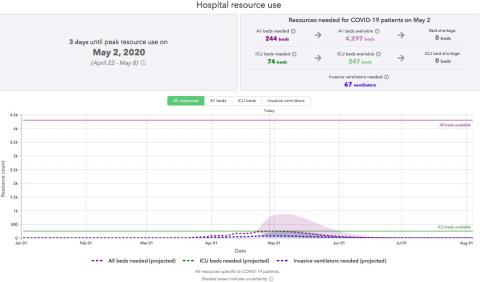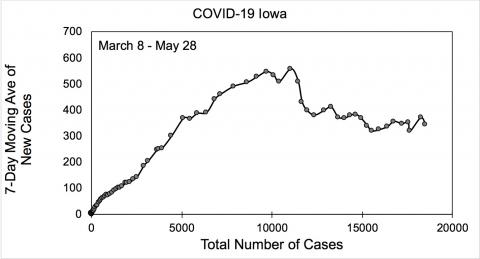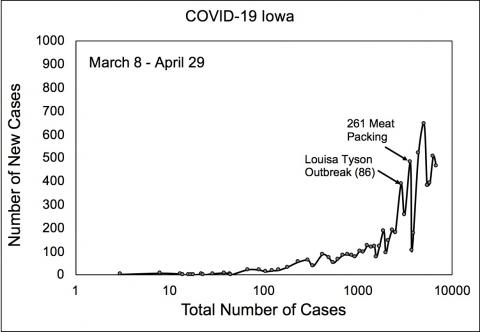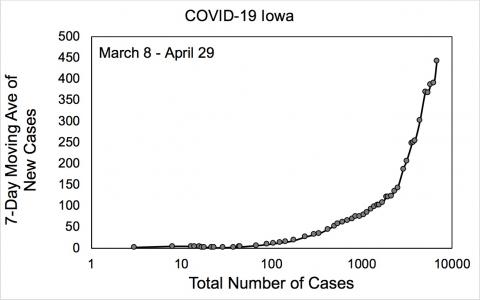
Because I am getting many questions from around the world, I am compiling resources here.
Working at Home Safety: https://occsafety.course.uiowa.edu
Please visit the Spring 2020 Occupational Safety class's web site (under construction) who is developing materials for how to work at home safely as their 'refocused' consulting project now that businesses are closed and not available to have students complete their project. There will be an email address to contact your question about safety when working at home that students can answer and develop materials to help you make data-based decisions.
COVID-19 Projections: https://covid19.healthdata.org/projections
The link above takes you to the University of Washington's IHME page. You can explore predictions of the US or specific state by using a pull-down list on the top green bar. Note that early on April 1, the peak Iowa rate was anticipated to hit around April 17/18. This has been revised to identify May 1 as now the peak resource date, at which time modeling indicates we are no longer able to meet the needed beds throughout the state.
Modeling on April 6:

Modeling on April 14 (peak pushed out to May 5; fewer needs for hospital beds and ventilators)

April 29 Modeling update: Peak now estimated May 2 (three days from now), based on mass gathering restrictions and "non-essential services" closed (to be lifted in 77 counties on May 1) and containment strategy in place after June 30.

Iowa Case Tracking
Data from daily case reporting (every day ~ noon) for the State of Iowa.

(Note: the above is not in log scale; each dot represents one 24-hour period)
Previous data (log scale)


Respiratory Protection/NIOSH Updates
NIOSH/CDC information repository page: https://www.cdc.gov/niosh/emres/2019_ncov.html
Crisis Situation strategies: https://www.cdc.gov/coronavirus/2019-ncov/hcp/respirators-strategy/crisis-alternate-strategies.html
FDA authorization for non-NIOSH approved respirator use in COVID-19 response: https://www.fda.gov/media/136403/download
N95 Respirator Decontamination studies (compilation started by David Remple, MD, at UCSF)
N95DECON detailed documents on decontamination and reuse of N95s (UV, hydrogen peroxide vapor, heat) were just released from the emergency national university collaboration (April 1, 2020): https://www.n95decon.org/publications
CDC guidance on decontamination and reuse of filtering facepiece respirators (March 31, 2020): https://www.cdc.gov/coronavirus/2019-ncov/hcp/ppe-strategy/decontaminati...
Procedures used at Nebraska Med for UVC: https://www.nebraskamed.com/for-providers/covid19
Procedures used at Duke Medical for hydrogen peroxide vapor: https://www.safety.duke.edu/sites/default/files/N-95_VHP-Decon-Re-Use.pdf
Webinar on 3/27/2020 from NETEC on N95 decontamination (Nebraska Med UV) and reuse: https://m.youtube.com/watch?v=Md2Qb3cdyeM
Battelle CCDS system for PPE decontamination for reuse: https://www.battelle.org/inb/battelle-critical-care-decontamination-syst...
Webinar on 3/31/20 covering Duke's N95 decontamination using vaporized H2O2: https://vmw-oesoapps.duhs.duke.edu/N95Webinar/GMT20200331-190119_Duke-He...
UPDATE (April 16, 2020): NIH Study Says N95 Respirators Can Be Decontaminated for Re-Use
According to an NIAID study, N95 respirators can be decontaminated effectively and maintain functional integrity for up to three uses. The study evaluated four decontamination methods and the authors concluded that vaporized hydrogen peroxide, ultraviolet light and 70-degree Celsius dry heat can be effective. The authors urge anyone decontaminating an N95 respirator to check the fit and seal over the face before each re-use.
Open Access COVID-19 Relevant Papers at JOEH
Use this UPDATED LINK to go to manuscripts at the Journal of Occupational and Environmental Hygiene that are relevant to COVID-19 and are free to the public. Send me a note if there is a paper that you think should be added.
Some Media Coverage that Tackles the Science
The Atlantic: Everyone Thinks They’re Right About Masks provides a good discussion of all of the debates underway regarding inhaled exposures and the issue of "masks" / "respirators".
Belgian-Dutch Computational Fluid Dynamics Study (link to Q&A) indicates that 6 ft distances apply when stationary and facing one another. If exercising, it is best to run/bike side by side, because particles exhaled will transport behind the runner. Recommendations to stay more than 5 m (16.4 ft) when walking behind someone fast-walking (4 km/h = 2.5 mph) ; 10 m (33 ft) behind someone who is running (14.4 km/h = 8.7 mph); and 20 m (65.6 ft) behind someone when biking (30 km/h = 18.6 mph). This has implications when working outside during windy days: maintain separations using these distances if you are positioned downwind of someone on windy days when working outdoors.
Recommendations for Workers
https://www.cdc.gov/coronavirus/2019-ncov/community/critical-workers/imp...
"Ready to Reopen for Business as Usual?"
For those of you looking for guidance on what needs to happen to "reopen" the country for business, this is a useful reference. This identifies specific things needed to prevent outbreaks after we get through our initial phase of "Slowing the Spread" (Phase 1 in the referenced document), including having vastly more screening tools and contact tracing personnel to identify and quarantine infected persons to prevent outbreaks. (As of April 16, we are clearly not ready to "open the country" based on these criteria.)